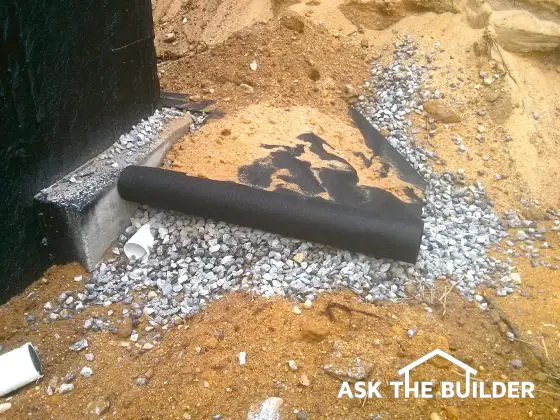Drain Tile Installation

The builder is doing just about everything right installing this drain tile. Photo Credit: Tim Carter
DEAR TIM: My last house had a basement that leaked water. I’m building a new home and want my basement as dry as the Atacama Desert. I’m confident that my drain tile was not put in correctly at my last house. What are the best practices when installing drain tile around a foundation? What materials would you use? What are the biggest mistakes you can make when installing foundation drain tile? Beverly H., Falls River, MA
DEAR BEVERLY: You’ve touched on a subject that’s near and dear to my heart. My college degree is in geology with a special interest in two things: geomorphology and hydrogeology. Those are fancy words for the study of the surface of the earth and the study of ground water. Both of those disciplines are in play when it comes to foundation drain tile.
The last home I built for my family had a basement as dry as the Atacama Desert. It wasn’t hard to achieve this and sadly most builders either don’t understand how to do it or they decided to go cheap at this phase of the construction.
Foundation waterproofing is a place you never want to go cheap or cut corners. The reason is simple. It’s extremely expensive and disruptive to have to go back at a later date and correct poor workmanship. Can you imagine digging up around your foundation after a house is built? You could be removing porches, tearing up sidewalks, driveways, expensive landscaping, rupturing buried utilities, etc.
If you want to go cheap and save money, then do it with your bathroom vanity faucet or any other thing in your home that you can replace at a later date with minimal work and effort. There are quite a few things you can do to save money on a home and come back a few years later to upgrade with relative ease as more money becomes available.
When it comes to foundation drain tile, let’s start first with the pipe. I happen to prefer the white 4-inch plastic pipe that comes with two rows of pre-drilled holes. I don’t like the corrugated pipe with the slits in it.
I’ve always installed the pipe with the holes oriented in the down position and lay the pipe on 2 inches of washed gravel that about the size of grapes. In the Midwest you normally find this gravel and its rounded. In other parts of the nation you may get similar sized stone, but it’s angular because they make it by crushing larger stone. No matter what type you use, just be sure that the gravel has no smaller pieces of stone or sand in it. You want all the stones to be the size of a grape or maybe a little larger. Water flows through this stone very fast.
I prefer to lay the drain tile along the side of the foundation footer, not on top of it. I want the level of the ground water to be as low as possible and placing the drain tile pipe on top of the footer usually forces the ground water table up to within a few inches of the top of the basement slab.
It’s vitally important that you apply true foundation waterproofing compound to the foundation walls as part of this system. That’s a subject for another column. Understand that simple hot asphalt spray is not waterproofing. It’s damp-proofing. There are rubberized asphalt-based waterproofing products that do work well.
The next step is to cover the drain tile with plenty of gravel. One of my customers years ago was so concerned about water leakage that he paid the extra money to backfill the foundation wall to within 6 inches of the final grade with the gravel. This was a little expensive, but it’s the best practice.
On most of my jobs I covered the foundation drain tile pipe with 30 inches of the washed gravel. The next step is mission critical. It’s vital that you cover the gravel with some material that captures the fine silt that will be present in the backfill dirt. I tried two things and they both worked well. I would scatter a 1-foot layer of straw on the gravel or I’d lay a piece of 30-pound asphalt-saturated felt paper on top of the gravel.
Realize when you dig up dirt it gets fluffed up. The volume increases usually by about ten percent and you disturb and free up fine silt. When this dirt is put back in a hole it settles. As rain passes through the dirt, it carries fine silt with it as it compacts the soil. This silt will readily clog drain tile pipe and the gravel rendering them ineffective. It’s mandatory that you protect the gravel and the pipe from this wretched silt.
You should also employ Mother Nature to help keep your new basement dry. This is where the geomorphology comes in. In a perfect world, you should build on a lot where the lowest part of your lot is at least three feet lower than the bottom of your foundation.
This allows you to use gravity to drain any water that makes it to your drain tile and is flowing through it. If you have a properly sloped lot, then the drain tile pipe is buried and extends all the way to a low point where it exits on the surface.
Many builders pipe this foundation drain tile to a sump and then it needs to be pumped out of the house. The issue with electric-powered sump pumps is they tend to fail in severe storms when the power goes out. This is when you most need a sump pump!
Column 1144
3 Responses to Drain Tile Installation